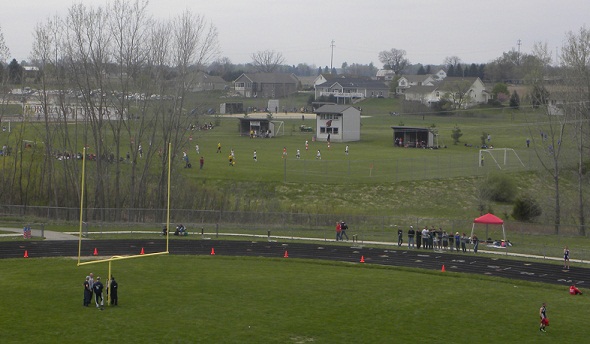
A-PLUS Idea: Portland Spring Carnival
April 25, 2012
A major challenge not just at the high school level, but in athletics as a whole, is the increasing number of competitors for people's time and money.
At Portland High School, local fans get a chance to check out nearly all the Raiders have to offer during a season that rarely draws football or basketball-sized crowds.
A decade ago, athletic director Kevin Veale looked at the unwieldly matrix of dates, times and sports fighting for spectators in his community, and decided to try something. This April 14, Portland hosted its 10th “Spring Sports Carnival."
“Every spring, we have a date when all of our spring sports host home events; except golf, because of its off-campus nature,” Veale said. “It’s a unique event, and from the top of the football press box it’s a pretty awesome scene to view baseball, softball, tennis, soccer and track events taking place at one time.
“Our crowds depend on the weather, of course. But the community has grown well aware of the event, and our local businesses and boosters get behind it,” he added. “We do special concessions, too. One year we barbecued half chickens, and this year it was cheeseburgers, with a lot of the food and supplies donated.”
PHOTO: From the football stadium press box, one simultaneously could watch track, soccer and softball competitions at Portland's Spring Sports Carnival, despite an overcast sky when this photo was taken. (Photo courtesy of Portland High School).

The More Things Change ...
December 20, 2013
By Rob Kaminski
MHSAA benchmarks editor
As we begin another calendar year, let's take a brief look at how the mission of school sports has (or hasn’t) changed since 1955, when former MHSAA Executive Director Charles E. Forsythe presented this practicum to the University of Michigan.
The following is an excerpt:
Presented by Charles E. Forsythe
Practicum in Physical Education
University of Michigan, Ann Arbor
Tuesday, June 21, 1955
WHY DO WE HAVE INTERSCHOLASTIC ATHLETICS IN OUR SCHOOLS?
 To meet the urge for competition which is a basic American tradition – let’s keep it.
To meet the urge for competition which is a basic American tradition – let’s keep it.- To provide a “whole school” interest and activity, bring in students other than athletes, enlist many student organizations.
- To teach students habits of health, sanitation, and safety.
- Athletics teach new skills and opportunities to improve those we have; this is basic educationally.
- To provide opportunities for lasting friendships both with teammates and opponents.
- To provide opportunity to exemplify and observe good sportsmanship which is good citizenship.
- Athletics give students a chance to enjoy one of America’s greatest heritages, the right to play and compete.
- One of the best ways to teach that a penalty follows the violation of a rule is through athletics.
- There must be an early understanding by students that participation in athletics is a privilege which carries responsibilities with it. Awarding school letter to a student is the second-highest recognition his school can give him – his diploma at graduation is the highest.
- To consider interscholastic athletic squad as “advanced” classes for the teaching of special skills – similar to bands, orchestras, school play casts, members of debating teams, etc. There is no reason why a reasonable amount of attention should not be given to such groups – as well as to those in the middle and lower quartiles in our schools. Both leaders and followers must be taught.
PHOTOS: (Top) Fans filled the arena for this MHSAA boys basketball tournament game. (Middle) Charles Forsythe served as the first executive director of the MHSAA.

